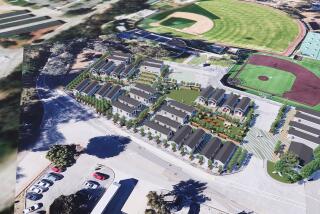Pasadena Compromise : Flagpole Offered as Tribute to Activist
PASADENA — The developers of a proposed $6.1-million industrial park have offered to erect a 40-foot flagpole in honor of the city’s first black real estate agent in an effort to end the furor over the planned demolition of the man’s former home on Lincoln Avenue.
The developers, Richard P. Stevens and his partners, Robert and Paul Grossman, had threatened last month to abandon their project in a blighted area of northwest Pasadena rather than obey the city’s order to build a monument to William Henry Harrison.
But Tuesday they appeared before the city’s Cultural Heritage Commission with a compromise, clearing the way for their plans to demolish Harrison’s home at 1330 Lincoln Ave.
The commission unanimously accepted the developers’ offer, saying the flagpole would be a fitting monument to Harrison, a black community leader and civil rights activist who died in 1955.
“I think everything is resolved,” said commission member Robert W. Winter.
But Stevens cautioned that after months of being “blackmailed” by the city and dealing with bureaucratic red tape, his offer was contingent on several conditions.
He said he will build the flagpole only if the city Board of Directors agrees to close a small alley that runs through the proposed project and donate to him a 5,000-square-foot plot of land at the end of the alley.
In addition, he said the Project Area Committee, which reviews construction projects in the Lincoln Avenue area, must approve the plans for the 80,000-square-foot development.
Stevens’ final condition is that both city agencies act on his demands in two weeks.
“If everyone doesn’t cooperate, that’s the end of it,” he said. “We’ve done our share. Now it’s their turn.”
While most city officials contacted Tuesday were pleased with Stevens’ offer, they were not sure they could meet all of his conditions.
“This is not a poker game,” said Director William Paparian. “It shouldn’t be a quid pro quo.”
Ernest E. Sanchez, chairman of the Project Area Committee, added that there was no way to guarantee approval of Stevens’ plan within the two-week deadline.
“We can just pledge to move as quickly as possible,” he said.
The controversy over the monument sprang from a city ordinance that gives the Cultural Heritage Commission the responsibility of reviewing any project that would affect a structure more than 50 years old.
The preservation ordinance was designed to slow the destruction of historically significant buildings in the city.
The commission cannot stop the demolition of a building, but it can delay destruction for up to a year.
In the case of Harrison’s home, the commission decided that the building was not architecturally important enough to save, said Chairman Kennon G. Miedema.
But panel members thought that some monument should be built to recognize Harrison’s historical importance, especially to northwest Pasadena.
“I strongly believe that young black kids need symbols today, and to obliterate them and walk away is wrong,” Miedema said.
Harrison came to California in 1911 with $1.50 in his pocket and eventually built a thriving real estate and construction business.
He was an active member of the NAACP who helped break down racial barriers in housing. He was also instrumental in the civil rights battle to integrate Brookside Pool.
Stevens was infuriated when he heard about the demand last month, saying: “Why should I as a developer of an industrial park build a memorial to anyone?”
But a few hours before the commission meeting Tuesday, Stevens and his partners came up with the idea of installing the flagpole in front of the project at the corner of Lincoln Avenue and Washington Boulevard.
Stevens said he had been considering erecting a flagpole in front of his industrial park and would have to add only a small plaque honoring Harrison.
He said the flagpole would cost about $5,800, nearly double the $3,000 that the commission thought should be spent on a monument.
But Stevens said he would not pay the additional $800 for the plaque, which he said residents and community groups should finance.
“I didn’t know the man,” he said. “If the community wants to honor him, fine.”
Stevens’ project manager, Earl F. Lyons, said about $450 has already been raised for the plaque.
The Project Area Committee is scheduled to begin its review of Stevens’ project next Tuesday, Sanchez said.
Although the issue of the monument appears to have been resolved, Stevens may face another controversy involving the relocation of the residents who live in Harrison’s home and other nearby buildings.
Sanchez said the committee has agreed that it will not approve the project unless tenants receive some help in finding new homes.
But Stevens said: “I don’t have to pay them for relocation. That’s the city’s problem. It’s not my problem at all.”
More to Read
Sign up for Essential California
The most important California stories and recommendations in your inbox every morning.
You may occasionally receive promotional content from the Los Angeles Times.










